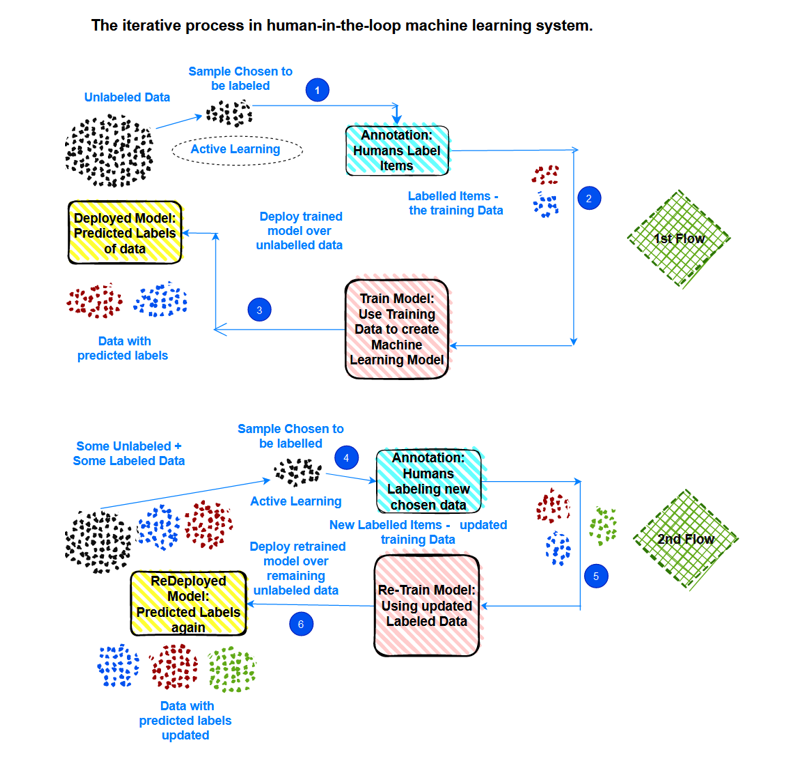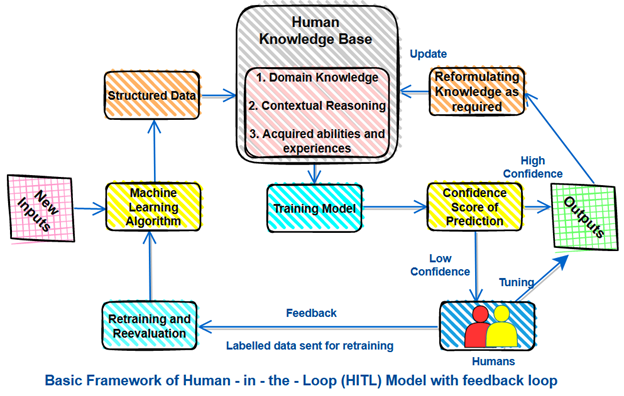
Integrating Human-in-the-Loop (HITL) in machine learning is a necessity, not a choice. Here’s why?
Last Updated on July 26, 2023 by Editorial Team
Author(s): Supriya Ghosh
Originally published on Towards AI.
Machine Learning

To integrate, Human-in-the-Loop (HITL) in Machine Learning, first and foremost is understanding HITL, its need, benefits, and approaches.
What is Human-in-the-Loop (HITL)?
Human-in-the-Loop (HITL) by all means is weaving together the human inputs and their feedback within the architecture of machine learning automation.
It starts with integrating the human-labeled/annotated data into the machine learning model and goes through a feedback cycle to train models to yield the desired output through the support of humans continuously.

Feedback triggers improvement of the model for predictions if the performance slips below a certain level of confidence.
In practice, it is always desirable to set the level of confidence acceptable for the model beforehand.
That means, the threshold can be set somewhat low, if it is fine to have few wrong predictions “coming in”, which in turn, requires much less human (manual) intervention.
On the other hand, if high level of accurate predictions are required, the degree of human (manual) interventions increases.
In simple words, the Human-in-the-Loop (HITL) approach combines the best of human intelligence with the best of machine intelligence.
How is the HITL design integrated into Machine Learning applications?
Machines are superb at making smart decisions from huge datasets, whereas people are better at making sound decisions even with less available information, sometimes based on their experience and intuition hence the design has to encompass both machines’ smart computational decisions and human’s right/ethical decisions.
Human-in-the-loop(HITL) in machine learning are designed in such a way that allows both sides(machines and humans) to interact continuously and includes a continuous feedback loop which enables feedback from the training, parameter tuning and testing tasks to be fed back into the algorithm so that it gets smarter, more confident, and more accurate.

This is especially effective for the system which selects by itself what it needs to learn next and sends those data to humans for labeling and training. This process of learning and improvement of the machines is known as Active Learning.
Active Learning is a way of ensuring that a model learns something useful from each of the new labelled/annotated data points created by the humans which it keeps encountering while moving ahead in the process.
Active learning is one of the most important aspect of machine learning models and when combined with Human-in-the-loop(HITL) delivers optimal results.
Few good examples are –
- Smart devices get smarter as they hear more and more voice signals and commands.
- Search engines get better by observing which websites people click for which specific search term.
- Autonomous vehicles get smarter, with observing more and more human drivers and riders.
What benefit does HITL offer to Machine Learning applications?
1. Many times data are incomplete and unambiguous. Humans annotate/label raw data to provide meaningful context so that machine learning models can learn to produce desired results, identify patterns, and make correct decisions.
2. Humans check the models for over-fitting. They teach the model about extreme cases or unexpected scenarios.
3. Humans evaluate if the algorithm is overconfident or low in confidence to determine correct decisions. If the accuracy is low, the machine goes through an active learning cycle wherein humans give feedback for the machine to reach the correct result and increase its predictability.
4. It offers a significant enhancement in transparency as application no longer appears as a Black box with humans involved in each and every step in the process.
5. It incorporates human judgment in the most effective ways and shifts pressure away from building “100% machine perfect ” algorithms to optimal models offering maximum business benefit. This in turn offers more powerful and useful applications.
What HITL strategies are to be employed in Machine Learning for maximum benefit?
1. Include all people who work with data involved in the application, including the people who collect, label, train, and conduct quality control on data.
2. Deploy people strategically at every stage in the process to improve and optimize models and their outcomes.
3. Deploy trained and managed human resources who can speed up the time to market and reduce the burden of data reworks.
4. Consider inducting the resources early in the lifecycle, if possible before model development begins, as machine learning models are endangered to outdated sooner than standard software systems because their performance relies heavily on data that is constantly evolving.
5. Refrain from poor utilization of people across the lifecycle as it can lead to poor quality data, higher costs, and model failure.
6. Full automation shouldn’t be the ultimate target as sometimes the best results are obtained only through humans(those with the right kind of knowledge and expertise) and machines cooperation and coordination.
7. Automation should strike the right balance between aspects that we find useful to automate, versus tasks where human participation remains meaningful. To embrace the extremes i.e., to rush into automating everything or to insist on automating nothing is never a win-win situation. Instead, ideal solutions often exist somewhere in between.
8. Whenever, there is an ethical decision making in question, for e.g. in cases where there is no clear right or wrong answer or there is a danger of machine failure due to the complex nature of decisions, human empowerment should be allowed to take precedence.
9. To solve complex environmental management problems, context-dependent human-led decision-making frameworks should be employed with proper risk assessments. Human checkpoints should not be overruled in any such cases.
10. Someone should be held accountable for the outcomes of the decisions of ML and AI applications, and that certainly can’t be machined. It has to be a human as the stakes and risks are too high for even a single wrong turn.
Human — Machine involvement Ratio as per scientists and researchers

Despite a large number of different domains and organizations using Machine Learning, the approach towards Human-in-the-Loop (HITL) has not been utilized to the required extent. It still remains a new field and needs to be carefully thought of, to be integrated with all of the machine learning applications.
But the good news is that — most of the industry experts have now realized its value and have geared up to include HITL in every ML and AI application.
Thanks for reading !!!
You can follow me on medium as well as
LinkedIn: Supriya Ghosh
Twitter: @isupriyaghosh
Join thousands of data leaders on the AI newsletter. Join over 80,000 subscribers and keep up to date with the latest developments in AI. From research to projects and ideas. If you are building an AI startup, an AI-related product, or a service, we invite you to consider becoming a sponsor.
Published via Towards AI
Take our 90+ lesson From Beginner to Advanced LLM Developer Certification: From choosing a project to deploying a working product this is the most comprehensive and practical LLM course out there!
Towards AI has published Building LLMs for Production—our 470+ page guide to mastering LLMs with practical projects and expert insights!

Discover Your Dream AI Career at Towards AI Jobs
Towards AI has built a jobs board tailored specifically to Machine Learning and Data Science Jobs and Skills. Our software searches for live AI jobs each hour, labels and categorises them and makes them easily searchable. Explore over 40,000 live jobs today with Towards AI Jobs!
Note: Content contains the views of the contributing authors and not Towards AI.














